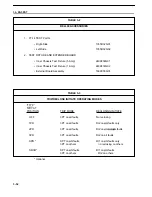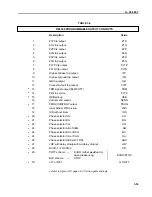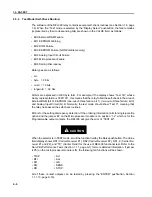
I.L. 40-385.7
4-9
way to change a setting locally would be to turn the dc power “OFF” and then “ON”. The com-
puter will allow for a local setting change within 15 minutes.
4.7.2
Communication Port Options
REL300 is supplied with a rear communications port. If the network interface is not specified,
a RS-232C (hardware standard) communications port is supplied. Network interface comm.
port option allows the connection of the relay with many other devices to a 2-wire network. A
detailed discussion of networking capabilities can be found in AD 40-600, Substation Control
and Communications Application Guide.
RS-232C ports are of the removable, Product Operated Network Interface (PONI) type and are
available in two styles. One is identified by a 25 pin (DB-25S) female connector, it is usually
black and has a single data comm. rate of 1200 bps. The second style is identified by a 9 pin
(DB-9P) male connector and externally accessible dip switches (next to the connector) for set-
ting the communication data rate. This port option is always black in color, can be set for
speeds of 300, 1200, 2400, 4800, or 9600 bps and offers an option for IRIG-B time clock, syn-
chronization input.
4.7.3
Connecting Cables
With each comm. port option the connecting cable requirement can be different. Also, connect-
ing directly to a PC or connecting to a modem, for remote communication, affects the connect-
ing cable requirements. Table 4-6, page 4-24 provides a summary of plug pin assignments,
pins required and cable connectors.
Some terminology will be defined to aid the user in understanding cable requirements in Table
4-6. Reference is often made to the “RS-232C” standard, for data communication. The RS-
232C standard describes mechanical, electrical, and functional characteristics. This standard
is published by the Electronics Industry Association (EIA) and use of the standard is voluntary
but widely accepted for electronic data transfer. ABB relay communications follows the RS-
232C standard for non-network data communication.
Although the RS-232C standard does not specify a connector shape, the most commonly used
is the “D” shape connector. As stated in Section 4.7.2 above, all ABB relay communication con-
nectors are of the “D” shape (such as DB-25S).
Data communication devices are categorized as either Data Terminal Equipment (DTE) or
Data Communication Equipment (DCE). A DTE is any digital device that transmits and/or re-
ceives data and uses communications equipment for the data transfer. DCE’s are connected
to a communication line (usually a telephone line) for the purpose of transferring data from one
point to another. In addition to transferring the data, DCE devices are designed to establish,
maintain, and terminate the connection. As examples, a computer is a DTE device and a mo-
dem is a DCE device.
By definition the connector of a DCE is always female (usually DB-9S or 25S). Similarly, DTEs
are always male (usually DB-9P or 25P). These definitions apply to the equipment being con-
nected and to the connectors on the interconnecting cables.
One additional piece of hardware that is required, in some applications, is a “null” modem. Null
modem’s function is to connect the transmit line (TXD), pin 2 (of a 25 pin connector) by RS-
232C standard, to the receive line (RXD), pin 3. A null modem is required when connecting like
Summary of Contents for REL-300
Page 26: ......
Page 28: ......
Page 29: ...I L 40 385 7 1 12 Figure 1 4 Simplified Block Diagram of REL300 Relay Sub 6 9651A07 ...
Page 36: ......
Page 37: ......
Page 38: ......
Page 39: ......
Page 40: ......
Page 41: ......
Page 42: ......
Page 43: ...I L 40 385 7 2 13 Figure 2 8 REL300 Outline Drawing Sub 2 2403F38 ...
Page 44: ...I L 40 385 7 2 14 Figure 2 9 REL300 Backplane Rear View Sub 11 2420F01 ...
Page 71: ...I L 40 385 7 3 27 Figure 3 1 REL300 Characteristics R X Diagram 9651A57 Sub 3 ...
Page 74: ...I L 40 385 7 3 30 Figure 3 5 REL300 Zone 1 Trip Logic 9661A16 Sub 1 ...
Page 75: ...I L 40 385 7 3 31 Figure 3 6 REL300 Zone 2 Trip Logic 9658A84 Sub 2 ...
Page 76: ...I L 40 385 7 3 32 Figure 3 7 REL300 Zone 3 Trip Logic 1504B04 Sub 1 ...
Page 78: ...I L 40 385 7 3 34 Figure 3 10 Loss of Potential Logic 9662A61 Sub 1 ...
Page 83: ...I L 40 385 7 3 39 Figure 3 17 Load Loss Accelerated Trip Logic 9656A33 Sub 2 ...
Page 85: ...I L 40 385 7 3 41 Figure 3 19 Reclosing Initiation Logic 1504B45 Sub 1 ...
Page 88: ...I L 40 385 7 3 44 Figure 3 24 PUTT Keying Logic Sub 2 9657A62 ...
Page 89: ...I L 40 385 7 3 45 Figure 3 25 Blocking System Logic 1504B89 Sub 1 ...
Page 94: ...I L 40 385 7 3 50 Figure 3 33 Composite Signal For Programmable Output Contacts Sub 2 1504B08 ...
Page 110: ...I L 40 385 7 4 13 Figure 4 1 REL300 Backplate Sub 8 1354D22 Sheet 4 of 5 ...
Page 111: ...I L 40 385 7 4 14 Figure 4 2 REL300 Backplane PC Board Terminals Sub 1 1611C78 ...
Page 112: ...I L 40 385 7 4 15 Figure 4 3 REL300 Systems External Connection Sub 3 1502B21 ...
Page 169: ...I L 40 385 7 B 7 Figure B 2 Test Connection for Three Phase Faults 1502B51 Sub 1 Sheet 2 of 4 ...
Page 181: ......
Page 182: ......
Page 183: ......
Page 184: ......
















































